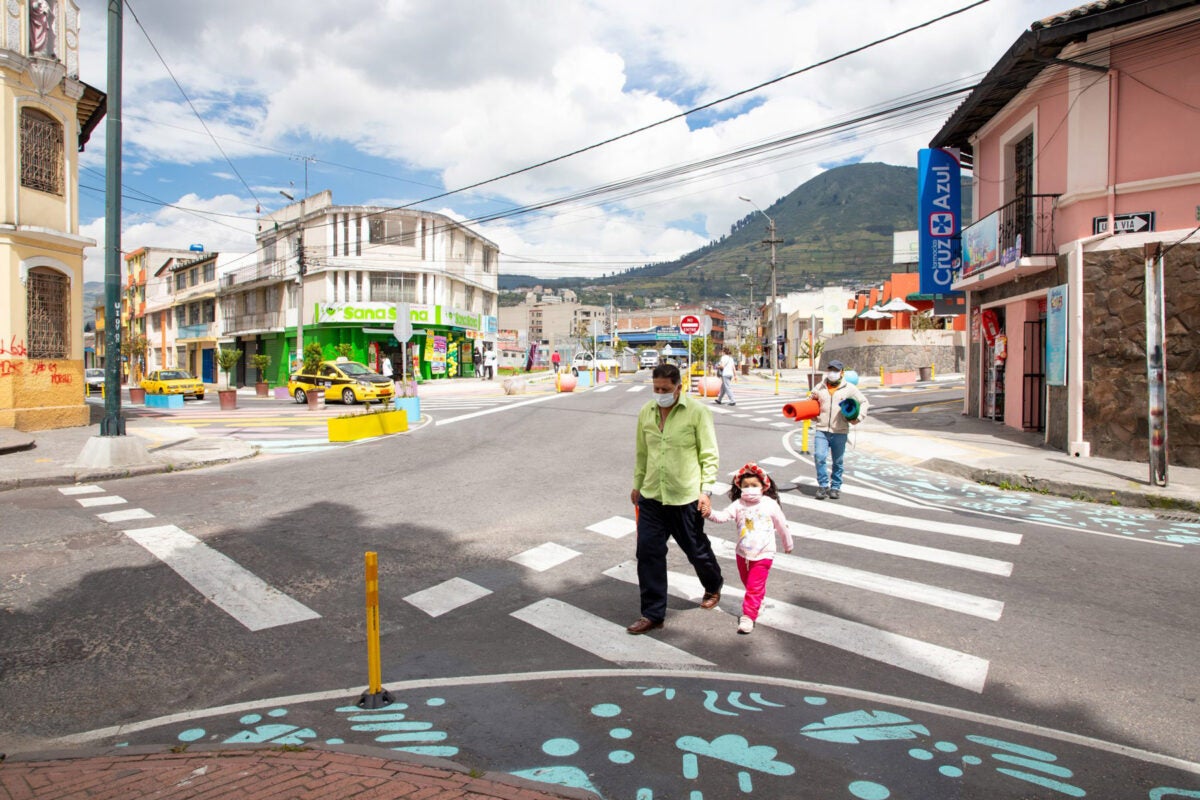
Opinion
Traffic deaths are a public health crisis in the U.S.
For years, I loved biking in New York City, especially across the Brooklyn Bridge on a wintry night, or zipping through the southern tip of Manhattan, with the Statue of Liberty in full view. I loved the feeling of freedom and the physical satisfaction—the air in my lungs, the cold on my cheeks, the burn of my muscles. But for every great ride, I heard a horror story about yet another New Yorker killed or grievously injured on a bike.
Finally, I heard one too many. When my friend’s mother-in-law, a public health worker, was killed by a bus while biking to work, I hung up my five-speed. Doing everything right as a cyclist only counts so much when you’re up against a massive hunk of metal.
That was more than a decade ago. In that time, New York and other U.S. cities have built hundreds of miles of bike lanes—making cyclists safer these days, I assumed. Still, when a friend encouraged me to hop back on my bicycle, I dug into the numbers first—and I found out that U.S. roadways are actually more dangerous than ever before.
Sign up for Harvard Public Health
Delivered to your inbox weekly.
Since 1975, deaths among cyclists have skyrocketed, and car crash fatalities have risen steadily, too. But pedestrians actually have it the worst. Over the last ten years, the number of pedestrians killed by cars has increased by 77 percent, reaching 7,600 deaths in 2021.
The data is clear. Traffic deaths are an epidemic. We must get serious about treating them as the public health crisis they are.
It’s worth considering why our roads have gotten so much deadlier. One indisputable fact: A biker or pedestrian is more likely to die if hit by an SUV than a sedan, as a body of evidence has found.
The problem is not only that the bigger cars weigh more than smaller ones—in some cases, twice as much—but that they hit cyclists and walkers higher up on the body, thereby causing more serious injuries. A new study by the Insurance Institute for Highway Safety (IIHS) looked at 18,000 crashes and concluded that bigger SUV’s with wall-like front ends are more dangerous than those with sloped fronts. Worse, the number of gargantuan vehicles on our roads just keeps growing: J.D. Power, the consumer research company, reported in November 2023 that eight in ten new vehicles sold globally that month were SUVs and trucks, sale numbers that have been roughly consistent for three years now.
Over the last ten years, the number of pedestrians killed by cars has increased by 77 percent, reaching 7,600 deaths in 2021.
That said, the core components of America’s tragic traffic story are long-time problems. “While it appears that the changing vehicle fleet is playing a role in a recent surge in pedestrian and cyclist fatalities, the major contributors to overall fatalities are the usual suspects—speed, impaired driving, and failures to buckle up,” says Joe Young, a spokesperson for IIHS.
Adam Snider, head of communications for the Governors Highway Safety Association, agrees. “Our roads are built for speed, not safety,” he says. The pandemic only made a bad situation worse. Empty roads meant drivers drove even faster—and recent data (along with the lived experience of pretty much everyone I know) suggests they haven’t slowed down since.
Given all this, David Ederer, an epidemiologist now with the Centers for Disease Control Prevention, argues that transportation officials should remake the roadways they oversee using a “safe systems” model, enlisting city planners to work with public health professionals to study where and how people die in vehicular accidents, and transform the built environment accordingly. Ederer lays out the case for this approach in a new paper based on doctoral research he conducted while at the Georgia Institute of Technology. “It’s easier to build a clean water system than to ask everyone to filter water at home,” Ederer says. Likewise, he believes that providing a safer network of streets, sidewalks, and bike lanes will save more lives than, for instance, trying to get people to quit using their phones while they drive. I agree.
Safe systems efforts have saved plenty of lives in other countries. In the late 1990s and early 2000s, Sweden, the Netherlands, and the United Kingdom began remaking roadways to improve safety, and traffic deaths per 100,000 people in each country subsequently declined by nearly five percent each year from 2000 to 2011 (meaning each country was able to halve the rate of traffic deaths over that time period, from roughly six to seven deaths per 100,000 depending on the country, to just over three deaths per 100,000 in 2011). In 2017, Bogota, Colombia opted for a similar approach, embracing a “Vision Zero” plan, with the ultimate goal of reducing pedestrian and cyclist deaths and serious injuries through 2026. The World Bank reported promising results for Bogota in a 2022 report: Strict speed limit enforcement on the city’s main thoroughfares resulted in 46 fewer pedestrian and cyclist deaths in 2019. Bogotá also built bike lanes across the city.
Any municipality serious about making drivers less dangerous to everyone around them should, at the very least, do two things, according to Veronica Lewin, spokesperson for the Bloomberg Philanthropies Initiative for Global Road Safety (BPIGRS). Reduce speed limits—to no more than 20 mph in urban areas—and invest in safer transit. That includes, Lewin says, “mass transit, bike routes, and walking infrastructure.”
BPIGRS works with 15 countries and 27 cities to improve road safety by taking a public health approach. Among other successes, they helped bring about one of the most-cited road revolutions in recent years: The Brazilian city of Fortaleza reduced traffic deaths by more than 50 percent in less than a decade, in large part by redesigning dangerous intersections and improving traffic laws. Fortaleza also asked local journalists to avoid words like “accidents” in their coverage; a 2019 study found that such terminology can make collisions seem mysterious and unavoidable rather than systemic and preventable.

An intersection in Quito, Ecuador that was redesigned as part of the Bloomberg Philanthropies Initiative for Global Road Safety increases pedestrian safety.
Photo: Bloomberg Philanthropies
Here in the U.S., the U.S. Department of Transportation is the latest big player to embrace the safe systems model. The long-term goal: to get road fatalities down to zero eventually, though the U.S. has not committed to a date. “We cannot tolerate the continuing crisis of roadway deaths in America,” Pete Buttigieg, Secretary of Transportation, said in a press release. The DOT’s effort will be funded by the Bipartisan Infrastructure Law, which has allotted $15.6 billion in money to be distributed to states to redesign roads and intersections.
In Oakland, California, Megan Wier and her team at the local Department of Transportation recently launched the Safe Oakland Streets initiative, which they developed with the local police department, the city’s Department of Race and Equity, and the city administrator’s office. The goals of the initiative include: preventing severe traffic crashes and eliminating crash inequities for historically disadvantaged communities, seniors, and people with disabilities (Black and Hispanic communities suffer from higher rates of traffic-related pedestrian deaths). “If we don’t focus our strategies on improving safety for our most vulnerable residents, we will never reach our goals of addressing severe and fatal crashes,” Wier says.
It’s high time for a sea change—not least because we don’t currently have much choice in how to get around. “Many people who might want to walk, cycle, or take transit simply don’t have that option,” as Ederer points out. “We’ve effectively made driving the only option for millions of Americans.”
Having done my own research, I’m convinced that changing our transportation system to favor mass transit, biking, and walking will save a lot more lives than trying to change individual behavior.
At the same time, every person reading this story could make roads safer by doing one simple thing: hanging up the phone when driving. If doing the right thing isn’t compelling, perhaps Erderer’s final plea might be.
“A safer roadway system,” he says, “[would also mean] people will spend less time sitting in traffic.”
Top image, source images: AerialPerspective Works /iStock, Toa55 / iStock



